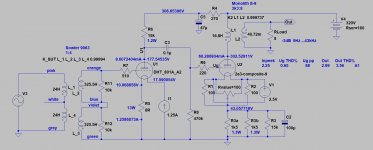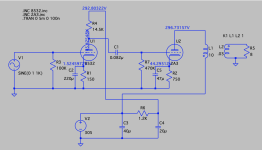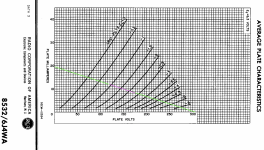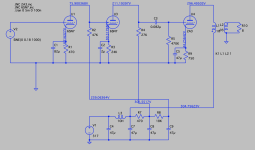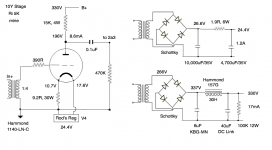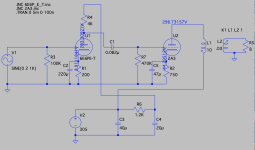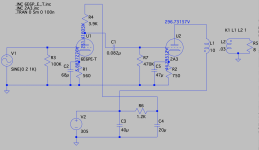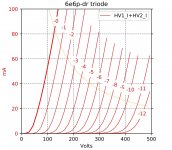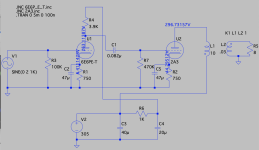The 10Y and 26 are in filament bias. This is a different way of doing it, but works very well with DHTs. Look carefully at the schematics and you will see how it's connected. The negative from the Coleman reg goes to ground. The positive goes to one side of the filament. The other side of the filament goes to ground THROUGH the cathode resistor. So the filament current is going through the cathode resistor. Hence the small value cathode resistor. You need to order a pair of Coleman V9 regs from Rod at Lyrima. He will explain everything.
Use the 26 by all means - it will work fine and sound nice. You will need the step-up transformer on the input, 1:4 ratio. Then you will have a 2 stage amp. You can use a plate choke if you want but this isn't necessary with a 26 and it's also hard to source a good one with inductance of 100K or more. I would stay with the resistor.
The filament supply for the Coleman reg needs to have a 25VA 12V transformer for EACH reg, no sharing. Or a 50VA 12+12V transformer, plus the usual caps and maybe a small dropper resistor.
Use the 26 by all means - it will work fine and sound nice. You will need the step-up transformer on the input, 1:4 ratio. Then you will have a 2 stage amp. You can use a plate choke if you want but this isn't necessary with a 26 and it's also hard to source a good one with inductance of 100K or more. I would stay with the resistor.
The filament supply for the Coleman reg needs to have a 25VA 12V transformer for EACH reg, no sharing. Or a 50VA 12+12V transformer, plus the usual caps and maybe a small dropper resistor.
Last edited:
Yes, the cathode resistor value would need to be higher, if only the anode current flows in itAndy, in the 2A3-10Y schematic, are you sure the 10Y cathode resistor isn't something more like 1.2K instead of 8.2R?
But in this case the filament current also flows in the cathode resistor - it's Filament Bias. With the filament current added, the resistor can be a very low value; this allows us to run without a bypass capacitor (usually, an intrusive electrolytic). With a low noise current, it works and sounds better.
Thanks Andy, Rod, and euro21 for explaining. I'll look into Rod's regulators as a potential option here.
Taking a break from work (What, me weekend?) to post something I'd meant to show the other week. Here are two spice models of triode-connected 6E6P running at about 200Vak/20mA. Out of curiosity, I modeled plate-loaded and choke-loaded versions, both with low-gain variations that remove the cathode bypass resistor. The input sensitivity for the choke-loaded version did not really change when removing the cathode bypass cap. Removing the bypass cap on the resistor-loaded version drastically lowered the input sensitivity from 2V to 4.25V, which pushes it into grid current territory and is probably not advisable (though I can't imagine ever pushing it that loud).
Input sensitivities
Ale' uses CCS and other technologies to optimize the 6E6P, but every time I've placed chips in the signal path it has killed the sound quality for me. I know some people hear major benefits from that, but my ears tend to prefer a vintage sound.
Anyway, the pair of 6E6P-DRY I purchased should be here in a week or two.
Taking a break from work (What, me weekend?) to post something I'd meant to show the other week. Here are two spice models of triode-connected 6E6P running at about 200Vak/20mA. Out of curiosity, I modeled plate-loaded and choke-loaded versions, both with low-gain variations that remove the cathode bypass resistor. The input sensitivity for the choke-loaded version did not really change when removing the cathode bypass cap. Removing the bypass cap on the resistor-loaded version drastically lowered the input sensitivity from 2V to 4.25V, which pushes it into grid current territory and is probably not advisable (though I can't imagine ever pushing it that loud).
Input sensitivities
- Plate-loaded, high gain: 2V
- Plate-loaded, low gain: 4.25V
- Choke-loaded, high gain: 1.3V
- Choke-loaded, low gain: 1.3V
Ale' uses CCS and other technologies to optimize the 6E6P, but every time I've placed chips in the signal path it has killed the sound quality for me. I know some people hear major benefits from that, but my ears tend to prefer a vintage sound.
Anyway, the pair of 6E6P-DRY I purchased should be here in a week or two.
Attachments
-
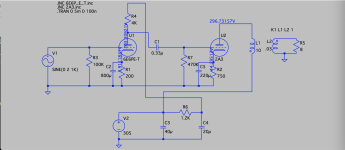 Screen Shot 2023-01-28 at 2.31.45 PM.png80.6 KB · Views: 157
Screen Shot 2023-01-28 at 2.31.45 PM.png80.6 KB · Views: 157 -
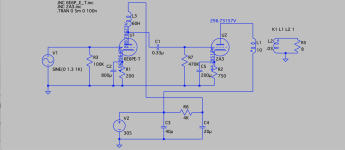 Screen Shot 2023-01-28 at 2.31.54 PM.png46 KB · Views: 157
Screen Shot 2023-01-28 at 2.31.54 PM.png46 KB · Views: 157 -
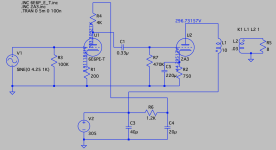 Screen Shot 2023-01-28 at 2.36.35 PM.png41 KB · Views: 155
Screen Shot 2023-01-28 at 2.36.35 PM.png41 KB · Views: 155 -
 Screen Shot 2023-01-28 at 2.42.51 PM.png41.7 KB · Views: 152
Screen Shot 2023-01-28 at 2.42.51 PM.png41.7 KB · Views: 152 -
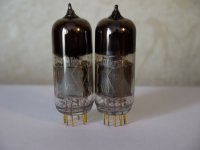 s-l1600-02.jpg124.9 KB · Views: 149
s-l1600-02.jpg124.9 KB · Views: 149 -
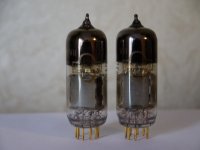 s-l1600.jpg126 KB · Views: 147
s-l1600.jpg126 KB · Views: 147
Last edited:
While playing around with ideas for a different project, I started thinking about the 8532 triode as an input tube. Bob Danielak ran it at about 150V/3-4mA to drive 1626 in his famous "Darling" circuit. However, looking at the 8532 plate curves, that current range puts the load line way down into the elbows. It's little wonder that it sounded muddled to me in complex music passages with the "Darling" headphone amp I made. The 10mA range is much more linear. So I tried modeling it in LTSpice at 150V/10mA, a safe dissipation range and a nice amount of current to drive the 2A3.
Here are screenshots of the 8532 load line at 150V/10mA and about a 305V supply (for a 45 headphone amp), and an LTSpice model of it driving a 2A3. With 2A3, the supply is about 295V -- close enough. The load line is not super duper linear, but way better than at the lower 3-4mA range.
Input sensitivity about 1V, which is good for a standard 2V source like a CD player or DAC. The 14.5K plate load resistor is just north of 3x the plate resistance of ~4.8K, which might not be super low for driving the 2A3 but it's also not that bad. High frequency cutoff will be very high, so that's not an issue. The cathode bias capacitors and coupling cap/grid leak combinations are designed to set the low frequency cutoff at around 4Hz.
I'm going to breadboard this combination sometime in the next week or two, when I'll have a little more time for fiddling.
Here are screenshots of the 8532 load line at 150V/10mA and about a 305V supply (for a 45 headphone amp), and an LTSpice model of it driving a 2A3. With 2A3, the supply is about 295V -- close enough. The load line is not super duper linear, but way better than at the lower 3-4mA range.
Input sensitivity about 1V, which is good for a standard 2V source like a CD player or DAC. The 14.5K plate load resistor is just north of 3x the plate resistance of ~4.8K, which might not be super low for driving the 2A3 but it's also not that bad. High frequency cutoff will be very high, so that's not an issue. The cathode bias capacitors and coupling cap/grid leak combinations are designed to set the low frequency cutoff at around 4Hz.
I'm going to breadboard this combination sometime in the next week or two, when I'll have a little more time for fiddling.
Attachments
I had a little time, so I swapped in a new circuit while the octal sockets are still at the input position on the breadboard. While looking up circuits for the 45 tube, I came across several threads raving about the Allan Eaton 45. Curiosity got the better of me, so I found some gut shots at Internet sales and began tracing the circuit in my mind, only to notice that it was very familiar. Turns out it's the SV 300B circuit (attached) that JC Morrison popularized in the Fi Primer, just with a 45 in the output section. Eaton also placed each 6SN7 stage on a separate RC section in the power supply, so I did the same. The SV 300B was the first from-scratch circuit I breadboarded--I liked it--after selling the Tubelab SE I had made as my very first amp project.
What interests me now about the SV circuit is that it direct-couples the first 6SN7 triode to the second, and then capacitor-couples the second triode plate to the output stage. So I pulled a couple of 6SN7s out of the closet, swapped in the right bits, and also changed the value of the second 6SN7 cathode resistor down to 24K to get the current up to about 3.3mA. This was to have enough current to drive the 2A3 grid, which I had calculated earlier to need minimum 2.3mA to avoid slewing problems. The attached screenshot from LTSpice shows all the resistor values and measured voltages that are actually on the breadboard, to which I'm listening as I type this.
Meh.
The bass is a little bloated, the clarity and detail are lackluster, the dynamics are a little dull, and it doesn't have that free, easy "inside the music" image that the SRPP 6SL7 produced. 6SN7 sounds wonderful in a cathode follower configuration when placed in front of 2A3 or even 300B run at 2A3 operating points (which is in my main system in the living room, a reverse-engineered George Wright WPA 3.5 with a 300B stuck in it). I bet the 6SN7 would also sound good in SRPP, though you'd need another preamp section in front of it. Maybe the 6-7K plate resistance is a liability, though tbh if you're going to run this tube as a voltage amp, then you'd probably want the plate voltage and current closer to 250V/9mA. Maybe I'll try that, but I probably won't because I'd like to try different things.
I'd been listening to the 6SL7 SRPP circuit for about 3 months (the typical one with 2.2K resistors and elevated heater voltage, a la JE Labs, Time Bandit, etc., posted early in this thread). The current across the 6SL7 was just north of 0.7mA, which is pretty low for driving the 2A3, yet it works very well to my ears. I tried swapping in 1K resistors to bring the current up to 1.1mA and get the load line up out of the elbows a little, just to hear if there was any difference (and if that arrangement might be somewhat ideal for driving a 45). I listened to that version for about the last week and found that the change slightly reduced the sonic dynamics and clarity, though going from wirewound to carbon film resistors might have been partly responsible. The 6SL7 SRPP with 2.2K resistors has so far been the best-sounding circuit by far.
I'll listen to this 6SN7 circuit for the week, but will then be moving on to the 6E6P-DRY, a pair of which arrived from Ukraine last week.
What interests me now about the SV circuit is that it direct-couples the first 6SN7 triode to the second, and then capacitor-couples the second triode plate to the output stage. So I pulled a couple of 6SN7s out of the closet, swapped in the right bits, and also changed the value of the second 6SN7 cathode resistor down to 24K to get the current up to about 3.3mA. This was to have enough current to drive the 2A3 grid, which I had calculated earlier to need minimum 2.3mA to avoid slewing problems. The attached screenshot from LTSpice shows all the resistor values and measured voltages that are actually on the breadboard, to which I'm listening as I type this.
Meh.
The bass is a little bloated, the clarity and detail are lackluster, the dynamics are a little dull, and it doesn't have that free, easy "inside the music" image that the SRPP 6SL7 produced. 6SN7 sounds wonderful in a cathode follower configuration when placed in front of 2A3 or even 300B run at 2A3 operating points (which is in my main system in the living room, a reverse-engineered George Wright WPA 3.5 with a 300B stuck in it). I bet the 6SN7 would also sound good in SRPP, though you'd need another preamp section in front of it. Maybe the 6-7K plate resistance is a liability, though tbh if you're going to run this tube as a voltage amp, then you'd probably want the plate voltage and current closer to 250V/9mA. Maybe I'll try that, but I probably won't because I'd like to try different things.
I'd been listening to the 6SL7 SRPP circuit for about 3 months (the typical one with 2.2K resistors and elevated heater voltage, a la JE Labs, Time Bandit, etc., posted early in this thread). The current across the 6SL7 was just north of 0.7mA, which is pretty low for driving the 2A3, yet it works very well to my ears. I tried swapping in 1K resistors to bring the current up to 1.1mA and get the load line up out of the elbows a little, just to hear if there was any difference (and if that arrangement might be somewhat ideal for driving a 45). I listened to that version for about the last week and found that the change slightly reduced the sonic dynamics and clarity, though going from wirewound to carbon film resistors might have been partly responsible. The 6SL7 SRPP with 2.2K resistors has so far been the best-sounding circuit by far.
I'll listen to this 6SN7 circuit for the week, but will then be moving on to the 6E6P-DRY, a pair of which arrived from Ukraine last week.
Attachments
I've spent years and years working on 300b and 2a3 circuits. My findings were these:
I was perplexed by this problem for a long while and tried solutions like using IDHTs like 6SN7 and 6N1P or putting op-amps in front of the first stage and using a DHT. What was hanging me up was trying a poor quality Lundahl step-up and assuming this wouldn't work. The breakthrough was a much better 1:4 SUT which I found in the Hammond 1140-LN-C. Then at last I could use 2 DHTs and say goodbye to IDHTs. I haven't looked back since.
It's like watching a video in slow motion seeing you go through all the stages I previously went through, including a 6e6. But these are the logical stages one would in fact go though so it's completely understandable. Maybe you'll end up in a different place in the end - most do. Not many use a 10Y driver stage - it's an expensive valve and you won't find it in commercial equipment outside of Thomas Mayer's exquisite builds. It's a big leap to make. I'm just lucky I have a few of them from a lucky purchase a few years ago when they were affordable.
- 2 stages always sounded better than 3 stages
- DHTs sounded better than IDHTs
- 2 stages with all-DHTs needed more gain
I was perplexed by this problem for a long while and tried solutions like using IDHTs like 6SN7 and 6N1P or putting op-amps in front of the first stage and using a DHT. What was hanging me up was trying a poor quality Lundahl step-up and assuming this wouldn't work. The breakthrough was a much better 1:4 SUT which I found in the Hammond 1140-LN-C. Then at last I could use 2 DHTs and say goodbye to IDHTs. I haven't looked back since.
It's like watching a video in slow motion seeing you go through all the stages I previously went through, including a 6e6. But these are the logical stages one would in fact go though so it's completely understandable. Maybe you'll end up in a different place in the end - most do. Not many use a 10Y driver stage - it's an expensive valve and you won't find it in commercial equipment outside of Thomas Mayer's exquisite builds. It's a big leap to make. I'm just lucky I have a few of them from a lucky purchase a few years ago when they were affordable.
All good points, Andy. And I've learned a lot from reading through your posts in this forum over the years. Now that I have a slightly better understanding of the physics and an operational knowledge of tubes, I'm trying to match that learning with experience. So for that reason, as you suggested, it's worth going through the process to reify everything in the mind and find out where my tastes and knowledge intersect.
I've got a pair of Lundahl OPTs coming some time this month for that 26 line preamp. But something tells me that pretty soon I'll be selling off a bunch of stuff I've made in order to boost the budget for a pair of 10Y's. The physics make a lot of sense for driving the 2A3.
I've got a pair of Lundahl OPTs coming some time this month for that 26 line preamp. But something tells me that pretty soon I'll be selling off a bunch of stuff I've made in order to boost the budget for a pair of 10Y's. The physics make a lot of sense for driving the 2A3.
Thanks for posting again, Andy. I'm going to try and get round to trying your circuit too.
I'm listening to Ravel's Bolero on the 6SN7-2A3 today and it's sounding better to me than yesterday. There's good tone and detail, and the dynamics are decent. There's a bit of graininess. It just doesn't quite have the attack and sustain, nor quite the timbre of acoustic instruments, of the 6SL7 SRPP. Properly adjusted for voltage and current, this could probably be made to work well with 2A3, maybe even better with a 45 output stage.
If I can finish my work early enough, I'll try to install the 6E6P-DRY tonight.
Jeff
I'm listening to Ravel's Bolero on the 6SN7-2A3 today and it's sounding better to me than yesterday. There's good tone and detail, and the dynamics are decent. There's a bit of graininess. It just doesn't quite have the attack and sustain, nor quite the timbre of acoustic instruments, of the 6SL7 SRPP. Properly adjusted for voltage and current, this could probably be made to work well with 2A3, maybe even better with a 45 output stage.
If I can finish my work early enough, I'll try to install the 6E6P-DRY tonight.
Jeff
You could try a 26 with a SUT. That would take you most of the way towards a 10Y driver stage. The 6SN7 as a driver is OK but the 26 will be better all round for tone. The Hammond 1140LN-C isn't too expensive. It's cheap in the UK - £40 each inclusive. I don't know if you can get that price in the USA. You'll need a pair of Rod's V9 regs as well. Then you're set up for any kind of DHT - 2P29L, 4P1L, 112A, 26, 46, 47, 10Y etc.
https://kgaenclosures.com/Hammond-Transformers/1140-LN-C.html
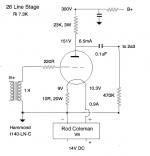
https://kgaenclosures.com/Hammond-Transformers/1140-LN-C.html

The Hammond 1140LN-C appears to be a little over $100 ea. before sales tax and shipping, which is comparatively a little more expensive than in the UK.
OK, another observation. The 6SN7 circuit takes longer to warm up than the 6SL7 one. After an hour of operation the sound is very noticeably improved. The 6SL7 SRPP is still clearly better, though.
That, or it's just my ears adjusting. 😆
OK, another observation. The 6SN7 circuit takes longer to warm up than the 6SL7 one. After an hour of operation the sound is very noticeably improved. The 6SL7 SRPP is still clearly better, though.
That, or it's just my ears adjusting. 😆
The 6SL7 SRPP is something I never got round to, so I can't make any comparisons.
Strange that the 1140LN-C is more expensive in the States. Hammond must be happy to sell it for £40 in the UK, and that includes the dealer markup. Maybe in Canada you can get a price? Could be cheaper to get a pair in the UK even. Actually, why not contact KGA and ask if Hammond can deliver them to your address in the States rather than to the UK - just pay KGA? They get them from Canada anyway. Could work. Speak to Gary Stares.
sales@kgaenclosures.com
Strange that the 1140LN-C is more expensive in the States. Hammond must be happy to sell it for £40 in the UK, and that includes the dealer markup. Maybe in Canada you can get a price? Could be cheaper to get a pair in the UK even. Actually, why not contact KGA and ask if Hammond can deliver them to your address in the States rather than to the UK - just pay KGA? They get them from Canada anyway. Could work. Speak to Gary Stares.
sales@kgaenclosures.com
Thanks. I'll shop around a little more and will reach out to KGA.
One more observation before I pause work to go cycling: what this 6SN7 circuit might lack in detail and clarity, it makes up for with complex program material, especially rock. It's driving single driver Lowthers and there is zero congestion when I blast gnarly Led Zeppelin songs and similar material. It might be worth developing 6SN7 to retain that drive while improving refinement.
One more observation before I pause work to go cycling: what this 6SN7 circuit might lack in detail and clarity, it makes up for with complex program material, especially rock. It's driving single driver Lowthers and there is zero congestion when I blast gnarly Led Zeppelin songs and similar material. It might be worth developing 6SN7 to retain that drive while improving refinement.
In my 6SN7 days I found that the angled anode types sounded the best. Even better were the 6J5 types with 2 top caps - DET20, CV6, CV1135. They were nice. Caution - the top caps are the other way round from the 7193 which doesn't sound so good. I have plenty of CV6/CV1135 if you're interested. They can be hard to find. I'd still go for a DHT but the CV1135 in particular was very nice.
I managed to install the triode-wired 6E6P-DRY last night, running it at 200Vak/20mA because that's how Ale' and another builder liked it (the attached LTSpice screenshot reflects the voltages I measured on the breadboard). I listened for about 2 hours. It sounded belabored. Not much zing, timbre, or inner magic; a disappointment compared to 6SL7. 20mA is overkill for driving the 2A3, so I thought about bringing the current down to the 8-10mA range, even though that would be close to the elbows in the plate curves provided by Bartola valves (also attached). I also thought the ceramic coffin 4K 25W resistors on the plate might have factored into the lack of clarity. I definitely notice better sound when wirewound resistors, for instance, are connected to the tube pins.
So, after listening again this morning and confirming my impressions, I swapped in 560R metal film cathode resistors to bring the op point to 250Vak/10.3mA (the attached LTSpice screenshot is mainly consistent with the breadboard measurements, except the plate voltage is just north of 255V, so there's an even 250V across the tube). The lower dissipation also allowed me to swap in smaller wirewound plate resistors (3.9K 3W), which is better for breadboard real estate too.
The sound is Much better. Big improvement in dynamics, detail, timbre, and clarity, if a touch of graininess I didn't hear with 6SL7 (to be fair, it's still warming up). I might swap in a pair of 750R cathode resistors to bring it down to about 255Vak/8.5mA later on.
Right now I'd place this about equal with 6SN7, so 2 or 3 in the order of preference, behind 6SL7 in SRPP, which just has so much more finesse and life.
So, after listening again this morning and confirming my impressions, I swapped in 560R metal film cathode resistors to bring the op point to 250Vak/10.3mA (the attached LTSpice screenshot is mainly consistent with the breadboard measurements, except the plate voltage is just north of 255V, so there's an even 250V across the tube). The lower dissipation also allowed me to swap in smaller wirewound plate resistors (3.9K 3W), which is better for breadboard real estate too.
The sound is Much better. Big improvement in dynamics, detail, timbre, and clarity, if a touch of graininess I didn't hear with 6SL7 (to be fair, it's still warming up). I might swap in a pair of 750R cathode resistors to bring it down to about 255Vak/8.5mA later on.
Right now I'd place this about equal with 6SN7, so 2 or 3 in the order of preference, behind 6SL7 in SRPP, which just has so much more finesse and life.
Attachments
This afternoon I swapped in a pair of 750R cathode resistors for the triode-wired 6E6P-DRY, netting an operating point of 260Vak/8.3mA, and listened for about 3 hours while I worked. 250Vak/10mA was slightly better.
I tested its drive ability with complex program material, blasting Led Zeppelin. As expected, it worked great for that.
A plate choke or interstage transformer might improve the finesse of 6E6P-DRY. Maybe I'll order one to try later, but I'm not sufficiently impressed with 6E6P to continue working on it at the moment.
The octal sockets will be going back to the input position on the breadboard so that I can try direct-coupled circuits with 6SF5 on input. However, while I still have the output stage set up for cap-coupling, I'm going to try 6SN7 in SRPP just for the hell of it, because it can reasonably deliver 2.5mA (with 2.2K resistors) to 4.5ma (with 1K resistors) to the 2A3 grid. The 3V input sensitivity will mean that it needs an additional input stage or a step-up transformer for a final build, but the 2V output of my laptop (streaming Tidal) should be enough for evaluation.
I tested its drive ability with complex program material, blasting Led Zeppelin. As expected, it worked great for that.
A plate choke or interstage transformer might improve the finesse of 6E6P-DRY. Maybe I'll order one to try later, but I'm not sufficiently impressed with 6E6P to continue working on it at the moment.
The octal sockets will be going back to the input position on the breadboard so that I can try direct-coupled circuits with 6SF5 on input. However, while I still have the output stage set up for cap-coupling, I'm going to try 6SN7 in SRPP just for the hell of it, because it can reasonably deliver 2.5mA (with 2.2K resistors) to 4.5ma (with 1K resistors) to the 2A3 grid. The 3V input sensitivity will mean that it needs an additional input stage or a step-up transformer for a final build, but the 2V output of my laptop (streaming Tidal) should be enough for evaluation.
Attachments
Now the DC voltage on R4 is too low (about 33V), and it cannot drive 2A3 full power output at all.
Andy could I ask what Lundahl step-up ratio or better model brand you disliked?I've spent years and years working on 300b and 2a3 circuits. My findings were these:
- 2 stages always sounded better than 3 stages
- DHTs sounded better than IDHTs
- 2 stages with all-DHTs needed more gain
I was perplexed by this problem for a long while and tried solutions like using IDHTs like 6SN7 and 6N1P or putting op-amps in front of the first stage and using a DHT. What was hanging me up was trying a poor quality Lundahl step-up and assuming this wouldn't work. The breakthrough was a much better 1:4 SUT which I found in the Hammond 1140-LN-C. Then at last I could use 2 DHTs and say goodbye to IDHTs. I haven't looked back since.
It's like watching a video in slow motion seeing you go through all the stages I previously went through, including a 6e6. But these are the logical stages one would in fact go though so it's completely understandable. Maybe you'll end up in a different place in the end - most do. Not many use a 10Y driver stage - it's an expensive valve and you won't find it in commercial equipment outside of Thomas Mayer's exquisite builds. It's a big leap to make. I'm just lucky I have a few of them from a lucky purchase a few years ago when they were affordable.
TIA
Felipe
- Home
- Amplifiers
- Tubes / Valves
- Developing a 2A3 SET
